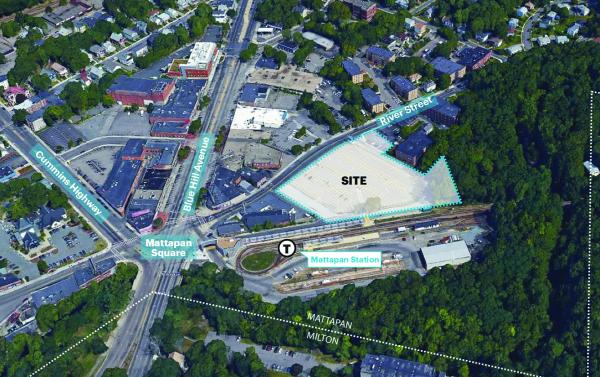August 15, 2019

A graphic from the BPDA shows the layout of the proposed redevelopment site next to the Mattapan T station.
A community meeting to discuss the status of a $57 million mixed-use development on what is now a little-used parking lot next to the Mattapan trolley station drew a small but vocal group of about 40 residents to the Mattapan branch of the BPL last Wednesday evening.
The 135-unit, six-story apartment building - alongside two rental townhouses – will be built by Preservation of Affordable Housing (POAH) and Nuestra Comunidad Community Development Corp., which have secured a 99-year lease for the land needed for the buildings.
The project won city approval last year, and with financing now in place, construction is slated to start next spring.
The building will have first-floor retail space, a community room, and the MBTA will continue to have 50 spaces in a lot for commuters. There will also be 40-45 spaces for residents of the new building.
A below-grade parking garage that was in the initial plan for the complex has been nixed due to a sheet of bedrock beneath the site, according to Charlie Dirac, a project manager with POAH.
Developers plan to add another parking area for 30-35 vehicles across River Street. Still, many residents of the new building will have to find off-site parking or rely on public transportation.
“The challenge that we are trying to address around housing we feel can be done with fewer parking spaces given the location of the site,” Dirac said. “This is going to be a great place to live for a great price for people who maybe accept the parking challenge.”
Those constraints were a point of dispute among the residents who spoke up at last week’s meeting. Besides traffic flow concerns, the project’s focus on affordability met general approval.
“We have been very intentional about creating opportunity and choice in this housing program for folks that live here today,” said Dirac. “When people talk about affordable housing, it tends to be skewed a little higher because the average income in the Boston is obviously pretty high.”
About 30 percent of the apartments will be “deeply subsidized” at 30 percent of Area Median Income (AMI), another 20 percent of the apartment will be pegged at 50 percent of AMI. Most of the other units will be at 60 and 80 percent AMI.
All of the units in this new development will be capped to remain affordable within the Area Median Income (AMI), which right now for Boston is about $100,000 a year for a family of four. For the apartments to be considered affordable, rent cannot exceed 30 percent of a household’s gross income. Mass Housing will peg 50 units at 80 percent of AMI through the Workforce Housing Program. These will be higher end units, considered close to market rate.
The development will also include a separate building with nine condo units. It will also have space on the ground floor of the main building for a sit-down restaurant with a liquor license and a community room. With immediate access to the Neponset River Greenway, the development emphasizes biking as a means of transportation and recreation.
Valerie Copeland, who grew up in Mattapan and recently moved back in 2015, hopes to see “quality retail space” in the complex.
“I’m all for small businesses, but we do need some higher quality choices in the neighborhood, and I understand that parking is an issue. But it’s an issue in the city. It’s just too many people, not enough land,” she said.
“I have faith that they’ve done the work that’s necessary in order to make the project work. We have these projects at other T stations in the city. The Red Line, Ashmont and Jackson Square. I’m actually happy to see something like that happening in Mattapan. I think it’s going to have a ripple effect into the square and bring more traffic and bolster the businesses that are already there.”
Another Mattapan resident, Beverley Johnson, pointed out that Mattapan Square is already a congested area on a good day, and that extra attention will need to be paid to pedestrian crossings. Also, the proposed restaurant space and the increasingly popular recreation areas around the development will make the square a destination.
“I don’t understand where people are really going to park,” said Johnson. “But people here don’t really take public transportation. When they come home in the evening, they want their car.”
Dirac said that the developers hope new amenities will serve residents who already live close by. “We are creating affordability in housing choice in an area where it was not. There are going to be people that do not have cars that are going to want to live here,” he said.


